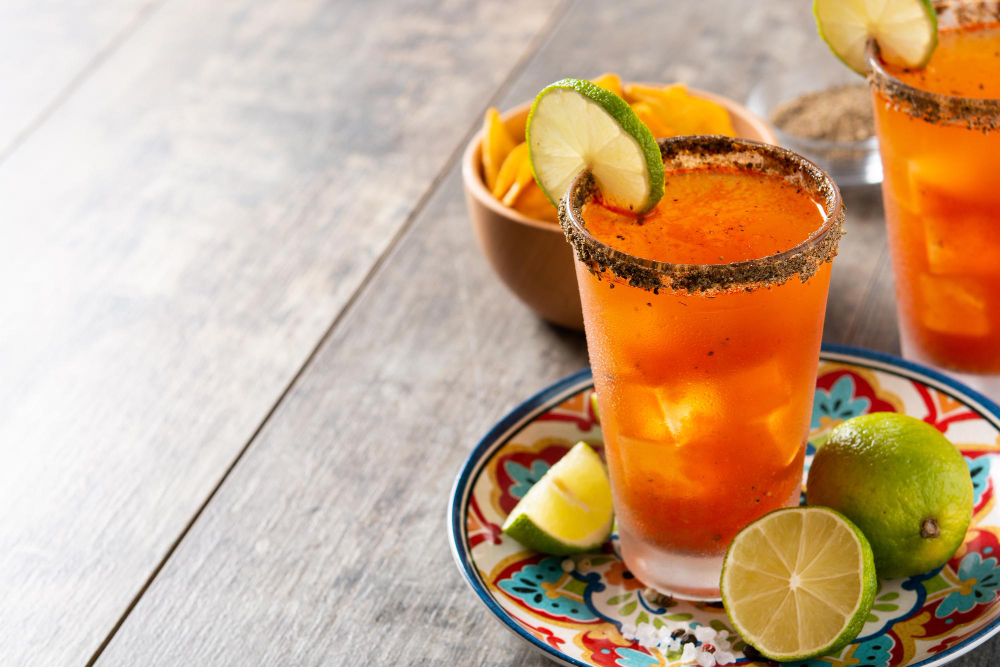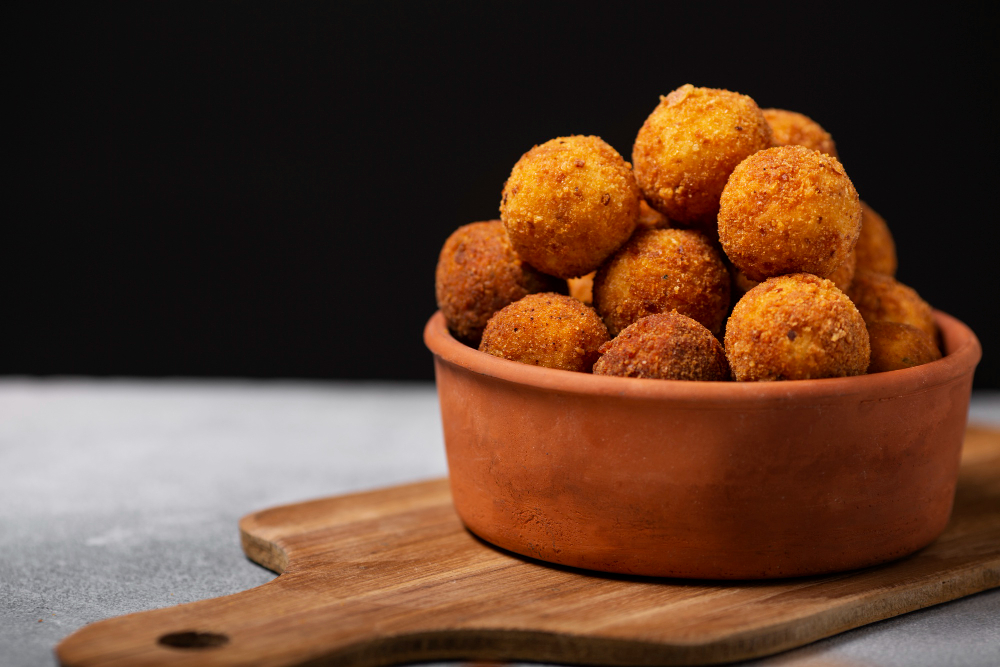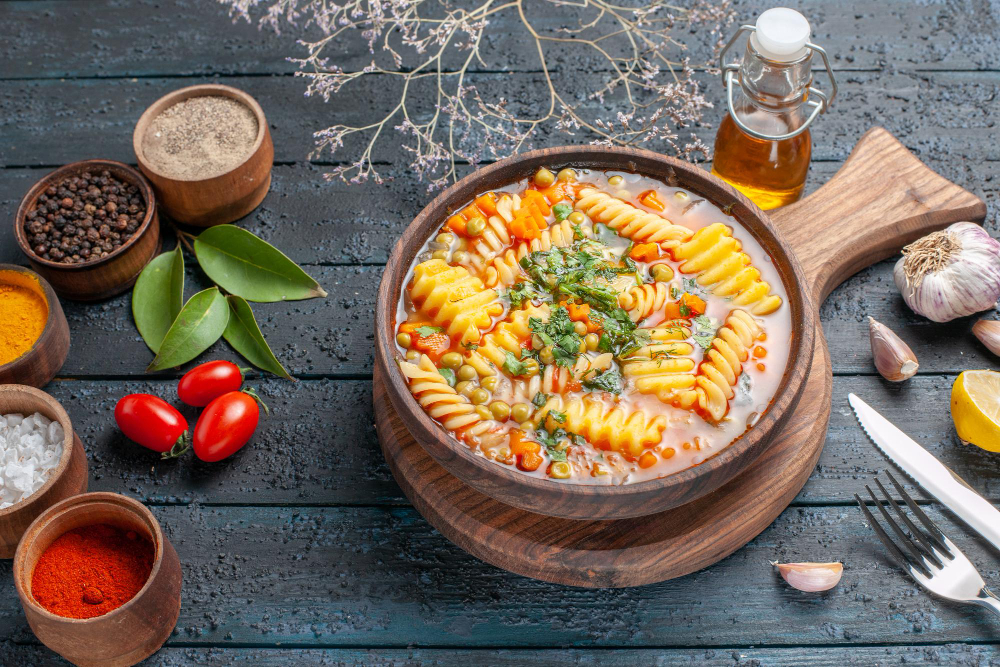Food And Drinks
Typical Puerto Rican Dishes: The 10 Delicacies You Must Try in Puerto Rico

Puerto Rico is known for its vibrant culture, stunning landscapes, and, most importantly, its rich culinary heritage. The island’s cuisine, which blends Taíno, Spanish, and African influences, offers a delectable array of dishes that reflect the island’s history and cultural diversity. When visiting Puerto Rico, indulging in its traditional foods is an essential part of the experience. From savory meals to sweet treats, here are the 10 must-try delicacies that capture the heart of Puerto Rican cuisine.
1. Mofongo
Mofongo is arguably the most iconic dish in Puerto Rican cuisine. It consists of mashed fried green plantains, seasoned with garlic, and traditionally served with a meat filling, such as pork, chicken, or shrimp. The plantains are typically fried until crispy, then mashed with garlic, olive oil, and chicharrón (crispy pork rinds), creating a dish with a rich, hearty flavor. Mofongo can be served as a standalone dish or as a side, often accompanied by a flavorful broth to enhance its texture and taste.
2. Arroz con Gandules
Considered the national dish of Puerto Rico, arroz con gandules (rice with pigeon peas) is a flavorful, rice-based dish commonly enjoyed during holidays and special celebrations. The key to its savory taste lies in the sofrito, a blend of onions, peppers, garlic, and herbs, which serves as the base of many Puerto Rican dishes. Arroz con gandules is cooked with pigeon peas, olives, capers, and pieces of pork, creating a harmonious blend of flavors that make it a staple in Puerto Rican households.
3. Lechón Asado
Lechón asado, or roast pig, is a beloved dish in Puerto Rico, especially during large gatherings and festive occasions. The pig is marinated with a mix of garlic, oregano, salt, and other spices, and then slow-roasted over an open flame, resulting in tender, flavorful meat with a crispy, golden-brown skin. The roasting process can take several hours, and it’s common to see entire families gather around for this traditional Puerto Rican feast.
4. Tostones
Tostones are another plantain-based delight that can be found throughout Puerto Rico. Unlike mofongo, which is made from mashed plantains, tostones are made by slicing green plantains, frying them, flattening them, and frying them again. They are served as crispy, savory chips, often accompanied by a dipping sauce such as garlic aioli or a tangy, zesty sauce. Tostones make for an excellent side dish or snack.
5. Pastelón
Pastelón is a Puerto Rican version of lasagna, but instead of pasta, it uses thin layers of sweet plantains. This dish perfectly balances sweet and savory flavors, with the plantains providing a natural sweetness that complements the seasoned ground beef filling. The layers are stacked together with cheese and baked until golden and bubbly. Pastelón is a crowd-pleaser, offering a taste of Puerto Rican comfort food that will leave you wanting more.
6. Alcapurrias
A popular street food, alcapurrias are fritters made from a dough of grated root vegetables, primarily yautía (taro root) and green bananas, stuffed with ground beef or crab. The dough is formed into a cylindrical shape, deep-fried until crispy on the outside, and tender on the inside. Alcapurrias are a go-to snack for locals and tourists alike, often enjoyed at beaches or street-side kiosks.
7. Bacalaítos
Bacalaítos are crispy, deep-fried codfish fritters that can be found at almost every festival or street vendor in Puerto Rico. Made from a batter of salted codfish, flour, and seasonings, bacalaítos are fried until they achieve a crispy, golden texture. These fritters are thin and crunchy, making them an addictive snack that’s perfect for any time of the day.
8. Sancocho
Sancocho is a hearty stew made with a variety of root vegetables such as yuca, plantains, and yautía, along with meats like chicken, beef, or pork. The stew is slow-cooked until the meat is tender and the vegetables are soft, resulting in a comforting and filling dish. Sancocho is typically enjoyed during cooler weather or on rainy days, offering warmth and sustenance in every bite.
9. Tembleque
For those with a sweet tooth, tembleque is a must-try Puerto Rican dessert. This coconut-based pudding is silky and smooth, with a delicate wobble (hence the name “tembleque,” which means “trembling”). Made from coconut milk, sugar, and cornstarch, tembleque is flavored with cinnamon and sometimes topped with a sprinkling of ground cinnamon. It’s a light yet indulgent dessert that provides a refreshing end to a savory meal.
10. Puerto Rican Hot Sauce (Pique)
Puerto Rican cuisine isn’t complete without a splash of its signature hot sauce, known as pique. Made from a blend of vinegar, hot peppers, and tropical fruits like pineapple, pique is a tangy, spicy condiment that adds a kick to any dish. Each family and restaurant has its own version of the Puerto Rican hot sauce, with varying levels of heat and unique ingredient combinations. This versatile sauce can be drizzled on everything from mofongo to tostones, elevating the flavor profile of any meal.
While Puerto Rican cuisine isn’t overly spicy, pique is used to add flavor rather than overwhelming heat, making it a popular addition for those looking to spice up their meals in a subtle yet impactful way.
Conclusion: A Culinary Journey Through Puerto Rico
Puerto Rico’s culinary offerings are a reflection of the island’s rich history and diverse influences. Whether you’re indulging in the savory goodness of mofongo or savoring the sweet simplicity of tembleque, Puerto Rican food offers a flavorful journey that captures the essence of the island’s culture. No trip to Puerto Rico is complete without trying these ten delicacies, each representing a piece of the island’s culinary soul.
And while you’re feasting on these iconic dishes, don’t forget to take home a piece of Puerto Rico with you—whether it’s a bottle of local pique to spice up your meals or any of the charming Puerto Rican souvenirs found in local shops. Embrace the flavors and memories of Puerto Rico long after your visit by keeping these little treasures as a reminder of your gastronomic adventure.
Food And Drinks
5 Cinco de Mayo Drinks to Spice Up Your Fiesta

Ever wondered why margaritas dominate Cinco de Mayo celebrations? While this iconic drink is a staple, there’s a whole world of vibrant, flavorful beverages that can elevate your fiesta. Whether you’re hosting a party or simply want to enjoy a festive drink, we’ve got you covered with expert-backed recipes, modern twists, and must-try classics.
Let’s dive into the best Cinco de Mayo drinks—beyond the basic margarita—that will impress your guests and keep the celebration lively!
1. The Classic Margarita (With a Twist)
No Cinco de Mayo is complete without a margarita, but why stick to the ordinary?
Why It Works:
-
Balanced flavors – The perfect mix of sweet, sour, and salty.
-
Customizable – Swap tequila for mezcal for a smoky twist.
Recipe:
-
2 oz reposado tequila
-
1 oz fresh lime juice
-
½ oz triple sec
-
½ oz agave syrup
-
Salt rim (optional)
Pro Tip: Use chili salt for an extra kick!
2. Paloma: Mexico’s Most Popular Cocktail
Move over, margarita—the Paloma is Mexico’s true favorite.
Why It Works:
-
Refreshing & light – Grapefruit soda (like Jarritos or Squirt) keeps it bubbly.
-
Easy to batch – Perfect for parties.
Recipe:
-
2 oz blanco tequila
-
½ oz lime juice
-
Grapefruit soda (to top)
-
Salt rim (optional)
Upgrade It: Use fresh grapefruit juice + club soda for a less sweet version.
3. Michelada: The Ultimate Beer Cocktail
If you love spicy, savory drinks, the Michelada is a must-try.
Why It Works:
-
Umami-rich – Combines beer with lime, hot sauce, and spices.
-
Hangover helper – The electrolytes from the spices help recovery.
Recipe:
-
1 bottle Mexican lager (e.g., Modelo or Victoria)
-
1 oz lime juice
-
2 dashes hot sauce (Valentina or Cholula)
-
½ tsp Worcestershire sauce
-
Tajín rim
Spicy Version: Add a splash of Clamato for a Chelada.
4. Horchata RumChata Cocktail
For a sweet, creamy alternative, try this spiked horchata.
Why It Works:
-
Dessert-like – Cinnamon and vanilla flavors pair perfectly with rum.
-
Non-tequila option – Great for those who prefer something different.
Recipe:
-
1.5 oz RumChata
-
1 oz vanilla vodka
-
1 oz horchata (store-bought or homemade)
-
Cinnamon sprinkle
Frozen Version: Blend with ice for a milkshake-style treat!
5. Mezcal Mule (A Smoky Alternative)
If you love Moscow Mules, this Mexican-inspired version will blow you away.
Why It Works:
-
Mezcal’s smokiness adds depth to the classic ginger-lime combo.
-
Copper mug optional – Serve over ice for simplicity.
Recipe:
-
2 oz mezcal
-
½ oz lime juice
-
4 oz ginger beer
-
Candied ginger garnish
Extra Kick: Add a dash of chili powder to the rim.
Bonus: Non-Alcoholic Agua Fresca
Not drinking alcohol? No problem! Agua fresca is a refreshing, fruity alternative.
Why It Works:
-
Naturally sweet – Made with fresh fruit and water.
-
Kid-friendly – Perfect for all ages.
Recipe:
-
2 cups chopped watermelon (or pineapple, mango)
-
1 cup water
-
1 tbsp lime juice
-
1 tsp honey (optional)
Blend, strain, and serve over ice!
Final Thoughts: Which Drink Will You Try?
Cinco de Mayo Drinks are all about bold flavors and festive vibes. Whether you’re sipping a spicy Michelada, shaking up a mezcal mule, or keeping it classic with a margarita, these drinks will make your celebration unforgettable.
Pro Hosting Tip: Set up a DIY drink station with different rims (salt, Tajín, chili powder) and let guests customize their cocktails!
Food And Drinks
Crispy Potato Balls Recipe: The Ultimate Comfort Food Snack

Ever crave a crispy, golden snack that’s creamy on the inside and perfectly crunchy on the outside? Potato balls are the answer! Whether you know them as croquettes, aloo balls, or papas rellenas, these bite-sized delights are a universal favorite.
In this guide, you’ll learn how to make restaurant-quality potato balls at home—crispy on the outside, fluffy inside, and packed with flavor. We’ll cover expert tips, variations, and even how to store them for later. Let’s get cooking!
Why You’ll Love This Potato Balls Recipe
✔ Easy to make – Uses simple, pantry-friendly ingredients.
✔ Versatile – Customize fillings (cheese, meat, herbs, or spices).
✔ Crowd-pleaser – Perfect for parties, snacks, or meal prep.
✔ Kid-friendly – A fun way to sneak in veggies or protein.
Ingredients You’ll Need
For the Potato Mixture:
-
4 large potatoes (Russet or Yukon Gold)
-
2 tbsp butter (or olive oil for dairy-free)
-
¼ cup milk (or plant-based milk)
-
½ tsp salt (adjust to taste)
-
¼ tsp black pepper
-
¼ tsp garlic powder (optional)
For the Filling (Optional but Delicious!):
-
½ cup shredded cheese (cheddar, mozzarella, or pepper jack)
-
¼ cup cooked bacon, ham, or ground beef
-
2 tbsp finely chopped herbs (parsley, chives, or cilantro)
For Breading & Frying:
-
1 cup breadcrumbs (panko for extra crunch)
-
½ cup all-purpose flour
-
2 eggs (beaten)
-
Oil for frying (vegetable, canola, or air-fryer option)
Step-by-Step Instructions
1. Prep the Potatoes
-
Peel, chop, and boil potatoes until fork-tender (~15 mins).
-
Drain well, then mash with butter, milk, salt, and spices until smooth. Let cool.
Pro Tip: Overcooked potatoes can get gluey—stop when just tender!
2. Shape the Potato Balls
-
Scoop ~2 tbsp of mashed potatoes, flatten slightly, and add filling (cheese, meat, etc.).
-
Roll into smooth balls (about 1.5-inch diameter).
Pro Tip: Wet hands slightly to prevent sticking.
3. Bread for Crispiness
-
Roll each ball in flour → dip in beaten egg → coat with breadcrumbs.
-
Chill for 15 mins (helps them hold shape while frying).
4. Fry to Golden Perfection
-
Heat oil to 350°F (175°C).
-
Fry in batches for 2-3 mins until deep golden brown.
-
Drain on a paper towel.
Alternative Cooking Methods:
-
Air Fryer: Spray with oil, cook at 375°F for 10-12 mins, flipping halfway.
-
Baked: Brush with oil, bake at 400°F for 20-25 mins.
5 Expert Tips for the Best Potato Balls
-
Use Starchy Potatoes – Russets or Yukon Golds hold shape better than waxy varieties.
-
Keep the Mixture Dry – Excess moisture = soggy balls. Drain potatoes well!
-
Double-Breading Trick – For extra crunch, dip in egg and breadcrumbs twice.
-
Freeze for Later – Freeze before frying, then cook straight from frozen (add 1-2 mins frying time).
-
Serve with Dipping Sauces – Try garlic aioli, spicy ketchup, or sour cream.
Creative Variations to Try
-
Loaded Potato Balls – Add bacon bits, cheddar, and green onions.
-
Spicy Version – Mix in jalapeños or chili flakes.
-
Veggie-Packed – Fold in finely chopped spinach or corn.
-
Sweet Twist – Swap salt for cinnamon, stuff with Nutella or jam.
Final Thoughts: Crispy Potato Balls Recipe
Crispy Potato Balls Recipe, creamy, and endlessly customizable—making them a foolproof snack for any occasion. Whether you fry, bake, or air-fry them, they’re guaranteed to disappear fast!
Now it’s your turn: Which filling will you try first? Cheese? Spicy beef? Or maybe a sweet surprise? Drop your favorite combo in the comments!
FAQs About Crispy Potato Balls Recipe
Can I make these ahead?
Yes! Prep and refrigerate for up to 24 hours or freeze for 3 months.
Why do my potato balls fall apart?
Potatoes may be too wet, or breading wasn’t packed tightly. Chill before frying.
Can I use sweet potatoes?
Absolutely! Adjust spices (try paprika or cumin for a savory twist).
Food And Drinks
Creamy Tuscan White Bean Skillet: A Comfort Food Masterpiece

Ever crave a restaurant-quality meal but dread the long prep time? Imagine a dish that’s creamy, garlicky, packed with protein, and ready in 20 minutes. That’s the magic of a Creamy Tuscan White Bean Skillet—a one-pan wonder that’s hearty, healthy, and bursting with Italian-inspired flavors.
Whether you’re a busy parent, a meal-prep enthusiast, or just someone who loves rich, comforting food, this dish delivers. Let’s break down why it’s a must-try, how to make it perfectly, and expert-backed tips to elevate it.
Why This Dish Works (Nutrition & Flavor Science)
Before diving into the recipe, let’s explore why this skillet meal is a nutritional and culinary powerhouse:
✅ Plant-Based Protein Punch – White beans (like cannellini) offer 15g protein per cup, plus fiber for lasting energy.
✅ Healthy Fats – Olive oil and a touch of cream (or dairy-free alternatives) provide satiating fats without heaviness.
✅ Umami & Depth – Sun-dried tomatoes, garlic, and Parmesan (or nutritional yeast) create a savory, complex flavor profile.
✅ Quick & Adaptable – Works as a main dish, side, or meal-prep staple—gluten-free, vegetarian, and easily veganized.
“Beans are one of the most underrated superfoods—they’re affordable, shelf-stable, and incredibly versatile.” — Dr. Mark Hyman, Functional Medicine Expert
The Ultimate Creamy Tuscan White Bean Skillet Recipe
Ingredients (Serves 4)
-
2 tbsp olive oil
-
4 garlic cloves, minced
-
1 shallot (or small onion), diced
-
1 tsp Italian seasoning
-
½ tsp red pepper flakes (optional)
-
2 cups cooked white beans (or 1 can, drained)
-
½ cup sun-dried tomatoes, chopped
-
1 cup baby spinach (or kale)
-
½ cup vegetable broth
-
¼ cup heavy cream (or coconut milk for vegan)
-
¼ cup grated Parmesan (or nutritional yeast)
-
Salt & pepper to taste
-
Fresh basil or parsley for garnish
Step-by-Step Instructions
1️⃣ Sauté Aromatics – Heat olive oil in a skillet. Add garlic, shallot, Italian seasoning, and red pepper flakes. Cook until fragrant (1-2 min).
2️⃣ Add Beans & Sun-Dried Tomatoes – Stir in white beans and sun-dried tomatoes. Let them soak up the flavors (2-3 min).
3️⃣ Deglaze & Simmer – Pour in broth, scraping up any browned bits. Add spinach and cook until wilted.
4️⃣ Creamy Finish – Reduce heat, stir in cream and Parmesan. Simmer until slightly thickened (3-4 min).
5️⃣ Garnish & Serve – Top with fresh herbs and a drizzle of olive oil. Pair with crusty bread or over pasta.
Pro Tips for the Best Results
1. Bean Choice Matters
-
Cannellini beans are classic, but Great Northern beans or even chickpeas work.
-
For creamier texture, mash a few beans before adding liquid.
2. Flavor Boosters
-
Lemon zest brightens the dish.
-
Miso paste (½ tsp) adds umami depth.
-
Crispy pancetta (or mushrooms) for a meaty twist.
3. Meal-Prep Friendly
-
Stores well for 3-4 days in the fridge.
-
Freezes beautifully—just omit dairy and add it fresh when reheating.
Why This Skillet Beats Takeout
-
Cost-Effective – A fraction of the price of restaurant meals.
-
Customizable – Swap in seasonal veggies (asparagus, zucchini).
-
Fast Cleanup – One pan = less mess.
“The combination of fiber, protein, and healthy fats in this dish helps stabilize blood sugar, making it a great balanced meal.” — Nutritionist Kelly LeVeque
Final Thoughts: A Dish You’ll Make Weekly
The Creamy Tuscan White Bean Skillet is proof that simple ingredients can create extraordinary meals. Whether you need a quick weeknight dinner or an impressive dish for guests, this recipe delivers.
Try it tonight and taste the magic of Tuscan comfort—without the fuss.
-

 Articles3 months ago
Articles3 months agoHow Many Times Can You Regrow Green Onions
-

 News11 months ago
News11 months agoUnderstanding HotLeaks: What You Need to Know
-

 Fashion8 months ago
Fashion8 months agoOpals in the USA: A Gemstone Transforming the Crystal Healing Market
-

 Entertainment8 months ago
Entertainment8 months agoHow to Use Snaptik: A Complete Guide to Download TikTok Videos
-

 Technology1 year ago
Technology1 year agoThe Wonders of Oh Em Gee Blog
-

 Entertainment1 year ago
Entertainment1 year agoBare it All: Unforgettable Skinny Dipping Stories Shared
-

 Health1 year ago
Health1 year agoCan You Smoke Shrooms? Exploring the Myths and Realities
-

 Articles5 months ago
Articles5 months agoWHAT IS THE DIFFERENCE BETWEEN SEED GARLIC AND FOOD GARLIC?
